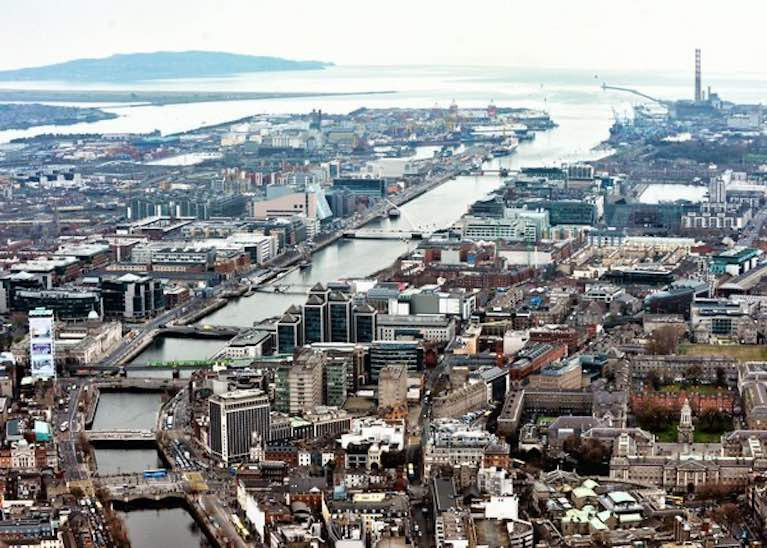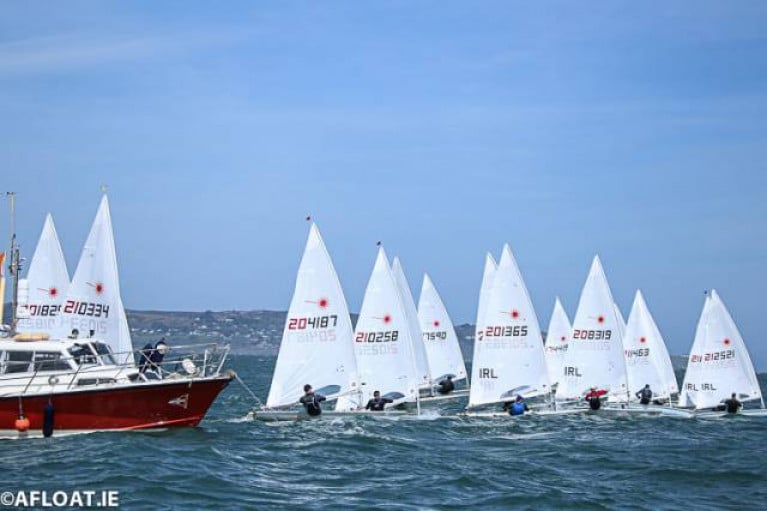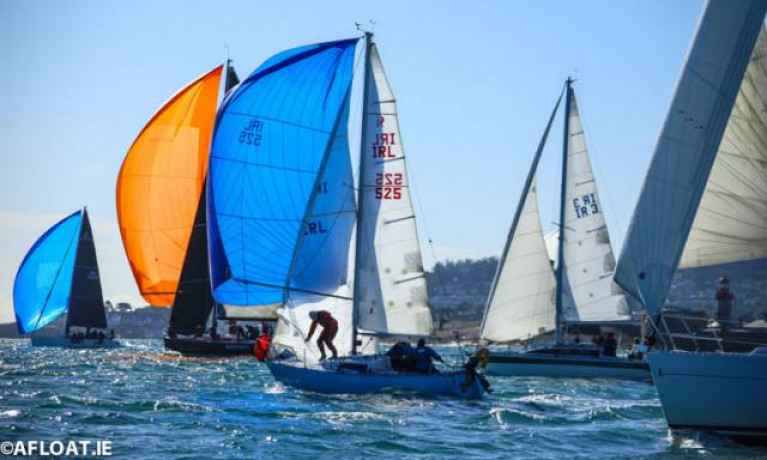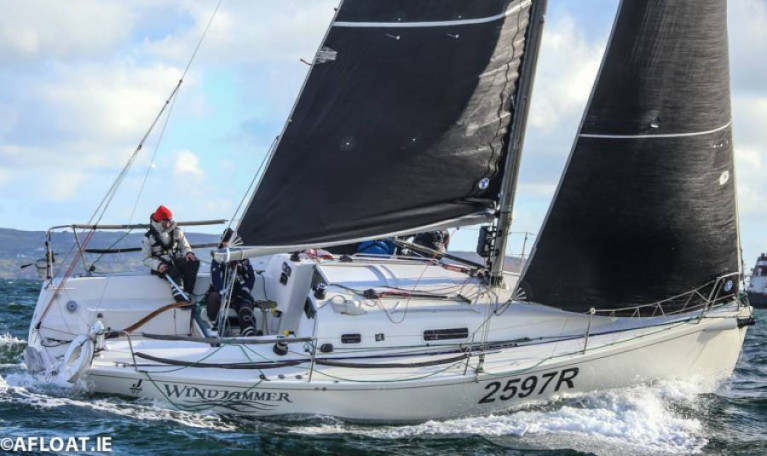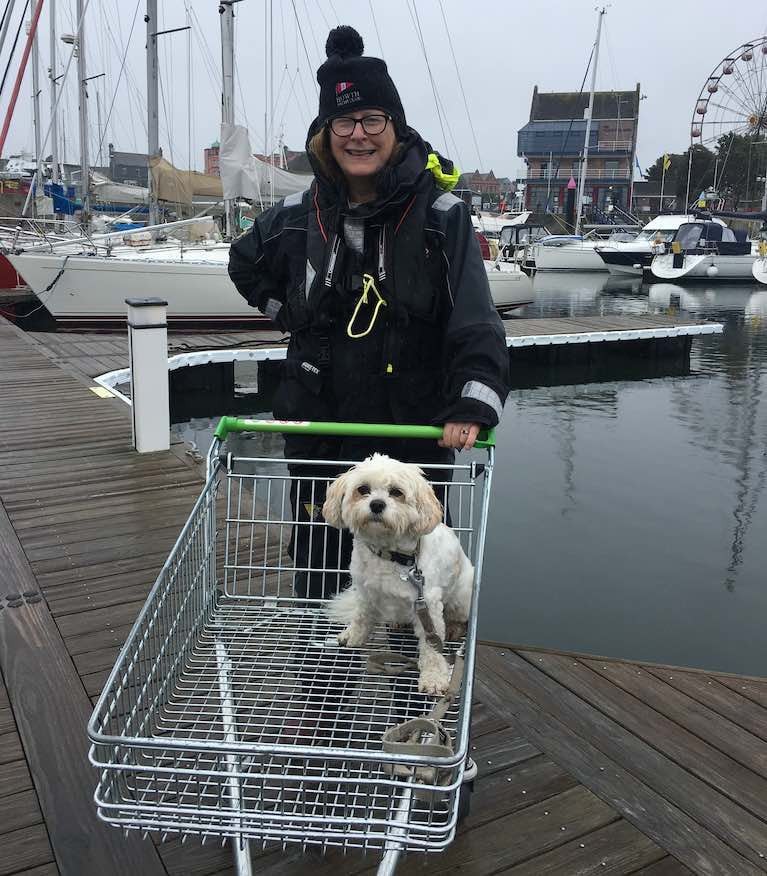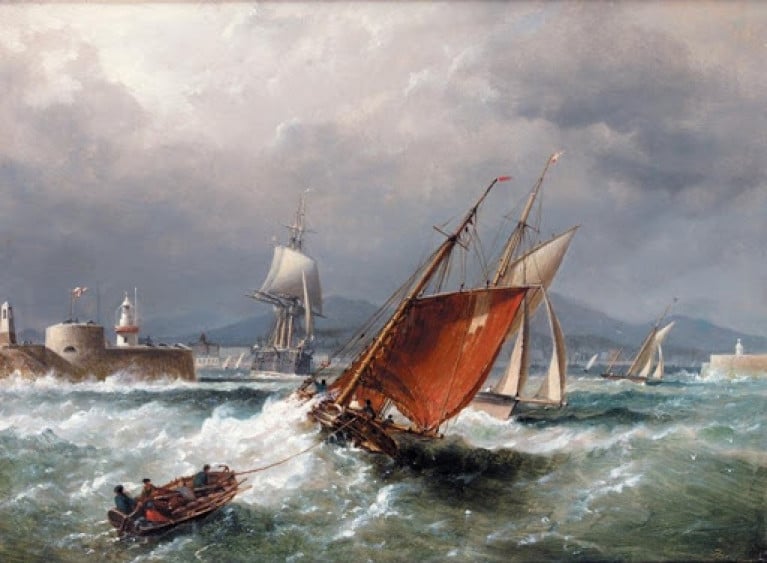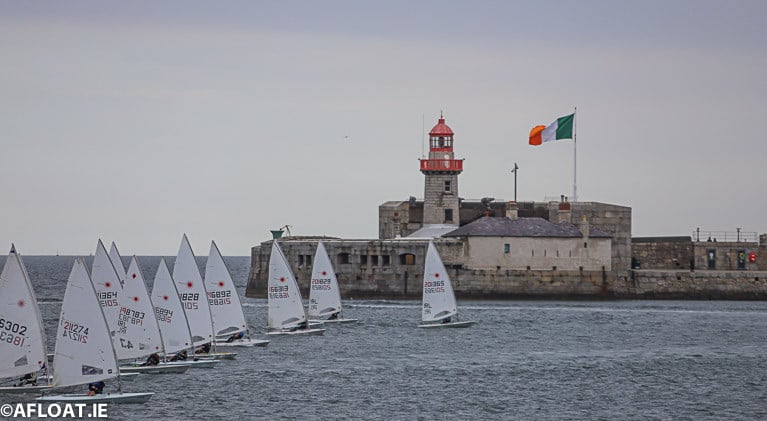Displaying items by tag: Dublin Bay
If you were asked to name the real centre point of modern Dublin, you'd probably dodge the question by saying that it's somewhere along a line through O'Connell Bridge and Trinity College, and on up Grafton Street or Dawson Street. Either way, that would definitely be locating the city's contemporary focus. Yet four hundred years ago, this modern central axis would have been regarded as being out in the sticks, down in the marshy inner edges of Dublin Bay.
When Trinity College was founded in 1592, its official title described it as being "Near Dublin". It was clearly eastward of the significant mediaeval city walls by slightly less than a mile, and eastward too of the main port area on the River Liffey, which was still centred around what had been the Dubh Linn, the "black pool" much favoured as a berth by the Viking's ships when they set up the makings of a settlement which first achieved some sort of civic status in 841.
 Dublin as it was when the book begins, as recorded by Herman Moll's map of 1714. Trinity College is shown as "near Dublin", while building on the north side of the new St Stephens Green has only recently begun. When development of the south side of what was to become Merrion Square was started close to the east of Stephen's Green, a selling point for the new Georgian houses was their "refreshing sea view".
Dublin as it was when the book begins, as recorded by Herman Moll's map of 1714. Trinity College is shown as "near Dublin", while building on the north side of the new St Stephens Green has only recently begun. When development of the south side of what was to become Merrion Square was started close to the east of Stephen's Green, a selling point for the new Georgian houses was their "refreshing sea view".
The central location around what had become Dublin Castle remained the heart of town for centuries. But while there was gradual expansion in every direction with the northsider/southsider psychological divide across the Liffey seeming to arise almost immediately – basically it was the Ostmen (the Eastmen or Danes) to the Northside, Normans on the Southside - the real engine of the city's power was always inclined to move eastward.
In his mighty yet very readable tome Dublin Moving East 1708-1844 – How the City took over the Sea, sailor/historian Michael Branagan has set in context the process whereby Trinity College and its environs have become the heart of the city through the machination of urban and port development, such that the main port area has undergone a major shift over the centuries, and is now well to the east of the College. So much so, in fact, that the entire estate of Dublin Port – one of the sponsors of this book - is on land which simply didn't exist when the "College of the Holy and Undivided Trinity" came into being.
The word that is generally used for this land is "reclaimed", as though the nefarious sea had originally pinched it from the decent people of Dublin while they were asleep. Nowadays, with global sea levels rising, how it's described may well become academic. But there is no doubt that - back in the era on which the book focuses - there was some extraordinarily effective land-grabbing going on in Dublin at the sea's expense.
The outcome is the shape of the city as we know it today, much of which results from buccaneering land "reclamation" and inspired development by some extremely determined and occasionally roughshod people whose wealthy descendants became the very souls of civic respectability.
Michael Branagan is a real terrier when it comes to research, and the numerous footnotes to each chapter will lead the enquiring reader along many fascinating pathways of unusual information. Thus it makes for ideal lockdown reading, and if you permit yourself one chapter every two days, there's a month of absorbing and informative reading here. At the end of it, Dublin and its port will never seem quite the same again, and it will certainly seem even more interesting.
 A city transformed in 140 years - Dublin as it was around 1850. It was still much smaller than it is today, but the basic work had been done – often with very primate equipment – to create the basic structure for a city moving east.
A city transformed in 140 years - Dublin as it was around 1850. It was still much smaller than it is today, but the basic work had been done – often with very primate equipment – to create the basic structure for a city moving east.
In fact, those who care about Dublin remaining a vibrant port should see this book as required reading, and clearly one of those who care about the port beyond the call of duty is Eamonn O'Reilly, Chief Executive of Dublin Port Company, whose thoughtful foreword is much more than the usual politely token introduction, as it gives us further insights into an extraordinary and pioneering city/port system.
In its entirety, the book gives a sense of deeper understanding of why Dublin should continue to embrace its commercial port, rather than becoming some sort of synthetic skyscraper city, with the real working maritime heart torn out of it for re-location to some soul-less container terminal landing pier in the middle of nowhere.
It has taken a lot to make Dublin the special and unique place it is. Suggesting that the port activities should be moved elsewhere "because that's what they do in other capital cities" is a very lame argument indeed. Dublin is Dublin, and rightly or wrongly in this remarkable place beside its bay between the mountains and the sea, we do things our own way - and our way includes having ships and city in dynamic interaction. Michael Branagan has done everyone a great service in detailing the key years in which a primitive river haven was launched – with the use of some very primitive equipment – towards the transformed situation where it was ready to become the fascinating port city that we know today.
 Dublin and its port and bay today. While much of the channelled River Liffey in the port has been planned, a very welcome unintended consequence of the building of the South Bull Wall - accelerated by the addition of the North Bull – has been the natural development of the extensive nature reserve of Bull Island in the north of Dublin Bay, created by wind-driven sand augmented by tide-carried silt. This photo also emphasizes the very special role of Dun Laoghaire as virtually the sole access point to Dublin Bay as a waterborne sports and leisure amenity for the large population of South Dublin
Dublin and its port and bay today. While much of the channelled River Liffey in the port has been planned, a very welcome unintended consequence of the building of the South Bull Wall - accelerated by the addition of the North Bull – has been the natural development of the extensive nature reserve of Bull Island in the north of Dublin Bay, created by wind-driven sand augmented by tide-carried silt. This photo also emphasizes the very special role of Dun Laoghaire as virtually the sole access point to Dublin Bay as a waterborne sports and leisure amenity for the large population of South Dublin
Dublin Moving East 1708-1844
By Michael Branagan
320 pp, fully illustrated
Published by Wordwell, €35.
Irish sailing's September Song Made Sweeter by its Brevity
Thank you, September. You did your best to provide us with good sailing as ingenious moves were implemented to run modified pandemic-compliant events which gave proper meaning to the season, and to our sailing traditions. It was neither your fault - nor ours - that in some places a situation beyond everyone's control caused a severe foreshortening of programmes carefully tailored to deal with circumstances which then seemed to change on a daily or even hourly basis.
For sure, some fortunate sailing centres managed to have limited sailing all month, scraping weekly sport out of the last of the daylight as the evenings rapidly closed in, and working the weekends with skill. But in other locations, the guillotine slammed down at mid-month, and people found that whatever good sailing they might have experienced now had to become recalibrated in the memory bank as highlights of their very truncated sailing year.
ROYAL CORK MAKES THE BEST OF IT
No club more thoroughly deserved a final full month of good fortune in September than the Royal Cork in Crosshaven, as they emerged battered but unbowed from what should have been their globally-focused Tricentenary. Most appropriately it was that renowned backbone-of-the-club, the National 18s, which saw September out with a flourish on its very last day, racing up and down the Owenabue River off the clubhouse on Wednesday evening as the twilight settled gently until this all-important month of September had only a matter of hours to run.
 Twilight for the Gods…..the National 18s at Royal Cork managed their last evening race – an in-river event off the clubhouse – on Wednesday, September 30th. The winner was Nick Walsh's Fifty Shades. Photo: Robert Bateman
Twilight for the Gods…..the National 18s at Royal Cork managed their last evening race – an in-river event off the clubhouse – on Wednesday, September 30th. The winner was Nick Walsh's Fifty Shades. Photo: Robert Bateman
With some more good luck, the club will be able to continue its Autumn League this weekend, but meanwhile like other sailing centres, Crosshaven and Cork Harbour found that September presented unusually meaningful opportunities to stage events which celebrated the places of sailing and its people, and in Cork Harbour, the come-all-ye event which best does this is Cove SC's annual Cobh to Blackrock Race.
Even though the Royal Cork had experienced its 2020 highlight in being the finish point for the successful pop-up Fastnet 450 Race in August, the Cobh-Blackrock Race is an ancient piece of the harbour's fabric, and September obligingly provided the conditions for a fast race and a real sense of occasion with life going on regardless.
 The Golden Oldie comes to town. The restored 1898 Cork Harbour One Design Jap, raced by Royal Cork Admiral Colin Morehead, reaches the finish of the Cobh-Blackrock Race. The CHODs are renowned for their pleasant steering characteristics - even on this gusty day, Jap's tiller is still in a very manageable fore-and-after position. Photo: Robert Bateman
The Golden Oldie comes to town. The restored 1898 Cork Harbour One Design Jap, raced by Royal Cork Admiral Colin Morehead, reaches the finish of the Cobh-Blackrock Race. The CHODs are renowned for their pleasant steering characteristics - even on this gusty day, Jap's tiller is still in a very manageable fore-and-after position. Photo: Robert Bateman
DUN LAOGHAIRE'S COMPACTED SEASON DEALT SUCCESSFULLY WITH REALITY
In Dun Laoghaire, Dun Laoghaire Motor Yacht Club's annual Kish Race is something that should in time be seen as a celebration of Dublin Bay, and in September 2020 is was shaping up that way as other events got the chop because of their inevitably high sociability quotient. Entries were flying up as racing round the Kish became more desirable than ever, but with a couple of days to go, the latest set of regulations wiped the race off the blackboard. That said, now that we know how much it can mean to the Dun Laoghaire sailing community, it's surely an all-comers cruiser-racer event which deserves more oomph in the future.
Meanwhile, as we write this there's still hope that some more racing will be squeezed out of Dun Laoghaire before the year is out. But for now, the image which best expresses the year and September in particular in its own special style is our header photo, which came our way on Thursday, September 17th from Cathy MacAleavey, and showed the finish of the previous evening's Water Wag Race, when 24 boats sailed in what might just turn out to be the last regular official race in Dun Laoghaire in 2020.
Thus what is already a richly atmospheric photo acquires extra meaning as Tim Pearson and his son Marcus in their 1995-built Little Tern cross first, narrowly ahead of Ian & Judith Malcolm in the 1915-built Barbara, while Martin and Triona Byrne in the 2019-built Hilda come in toward a third-place on port tack. There's a whole universe in that photo and it's one of the gifts which September's sailing has given us.
 The Goodbody family's J/109 White Mischief was one of the most successful contenders in Dublin Bay SC's compacted but very busy season. Photo Afloat.ie
The Goodbody family's J/109 White Mischief was one of the most successful contenders in Dublin Bay SC's compacted but very busy season. Photo Afloat.ie
But another gift in Dun Laoghaire Harbour was the way Dublin Bay SC managed to keep things going from mid-July to mid-September, with evening and weekend racing for cruisers, keelboat and dinghies pushing comfortably over the hundred boat mark in a successfully-controlled operation which was a model of compliance.
HOWTH FINDS HEART IN LAMBAY
Round the corner in Howth meanwhile, although their time-honoured annual race round Lambay was to disappear in the cancellation of the Wave Regatta in which it now plays a central role, when the carefully-monitored Aqua Double-Hander was staged in July with 38 boats, it was raced round Lambay on a day of sublime sunshine which eventually may result in the summer weather of 2020 being remembered as even better than it actually was.
 This was September 2020 – the Howth 17's Leila and Anita in the race round Lambay. Photo: Annraoi Blaney
This was September 2020 – the Howth 17's Leila and Anita in the race round Lambay. Photo: Annraoi Blaney
Yet it was back to classic Atlantic westerlies in on some days in September when the heroically curmudgeonly veterans of the 122-year-old Howth Seventeen Class decided they'd race round Lambay on September 5th, with the winning 1907-built Deilginis seeing off the 16 miles course in a record time. This was in a race which was started in sunshine captured by rising photographic star Annraoi Blaney in a striking shot which will now be one of the style-setting photos of this brief but sweet sailing season.
They'd a longer burst of September sunshine in Howth at mid-month when the Autumn League got underway, each weekend's racing spread over both days but only one day of racing for each class, which helped social distancing as they'd 79 boats entered in all for what turned out, alas, to be just one weekend before the chop.
 "Just the best day's sailing ever". Simon Knowles' J/109 Indian in hot pursuit of the Classic Half Tonners Mata, King One and Big Picture in the first (and so far only) weekend of the Howth Autumn League. Photo: Judith Malcolm
"Just the best day's sailing ever". Simon Knowles' J/109 Indian in hot pursuit of the Classic Half Tonners Mata, King One and Big Picture in the first (and so far only) weekend of the Howth Autumn League. Photo: Judith Malcolm
If the Dublin Shutdown really does become just a three-week imposition, then it will be everything up and running again after midnight on Friday, October 9th. But we don't see anyone betting on that, and for now, the Howth recollections of September sailing are best summed up by J/24 National Champion Sam O'Byrne, who was racing in Howth with father-and-son superstars Darren and Rocco Wright on the winning Classic Half Tonner Mata in that one opening race, with Sam subsequently commenting: "It was the best and pleasantest day of sailing I've ever had, full stop".
BELFAST LOUGH CELEBRATES DIVERSITY WITH LUFRA CUP
Up on Belfast Lough the celebration of the local sailing waters used to happen on the 12th July, when folk ashore had marching business on their mind, but those afloat at Ballyholme traditionally had a day-long race right round the lough. This was easily done thanks to conveniently placed navigation markers at every corner, such that you'd to face a course which could seem very long indeed if you were racing it in one of the 18ft Waverley Keelboats, or the 22-footers of the Bay Class.
However, that's a classic of the olden days which no longer seems to be sailed, but another Ballyholme tradition which is still going strong to celebrate the local sailing water is the Lufra Cup, which Betty Armstrong of this parish was reporting a couple of weeks ago. Nobody knows when this pursuit race – they called it the Menagerie Race until Howard Finlay presented the Lufra Cup after his 12-ton Watson cutter of that name had won in 1943 to find there as no proper cup – and ever since the Lufra Cup has been Ballyholme YC's September Classic, a race officer's nightmare and a handicapping anorak's dream, with boats streaming across the starting line in an endless procession of different starting times, and the finish seeing half a dozen boats of very different types trying to get across that line first, with a 15-ton gaff cutter winning one year, and an International Cadet winning it the next with the 15-tonner's bowsprit right over her very junior helm as he crossed the line.
 Once a winner of the Lufra Cup at Ballyholme, the 1893 Dun Laoghaire-built Marie was designed by Maimie Doyle, who later designed the transom-sterned Water Wags. Photo: W M Nixon
Once a winner of the Lufra Cup at Ballyholme, the 1893 Dun Laoghaire-built Marie was designed by Maimie Doyle, who later designed the transom-sterned Water Wags. Photo: W M Nixon
This September it was won by Gareth Martel in his Beneteau First 40.7 Pippa, and he found himself the custodian for a year of a trophy which is a significant historical record in itself, for the inscribed list of winners going back 77 years is a history of the development of sailing of the last three-quarters of a century.
Every conceivable boat type seems to have figured at some stage, including Lasers sailed by Chris Boyd and Wic McCready, and the venerable 26ft gaff cutter Marie, designed by Maimie Doyle in Dun Laoghaire in 1893, built by her father J E Doyle, and now owned by Roy Ashton of Groomsport after a lifetime of epic sailing history which included being the first boat to be awarded the Irish Cruising Club's Faulkner Cup back in 1931.
LOUGH REE, CONNEMARA & GLANDORE
Thanks to September's sailing, we were reminded of such things, but equally, September 2020 brought together past and present and future in dynamic ways, a good example being the Jonny Swan-organised Homecoming Regatta at the 250-year-old Lough Ree Yacht Club which saw cruisers, dinghies, Shannon One Designs and SB20s finding brisk breezes and sunshine.
 SB20 racing on Lough Ree with September 2020 Junior Sailor of the Month Ben Graf on the helm. Photo: Alex Hobbs
SB20 racing on Lough Ree with September 2020 Junior Sailor of the Month Ben Graf on the helm. Photo: Alex Hobbs
Then too, September reminded us that a thriving Flying Fifteen Class continues to develop in the heart of Connemara at Casla, with 27 boats appearing for an on-going league from all the hidden places in that totally inter-twined Land of the Sea, and Ronan O'Briain winning the two last races of September at the weekend.
 A new tradition in the heartland of traditional boats? September racing for the growing fleet of Flying Fifteens at Casla in Connemara
A new tradition in the heartland of traditional boats? September racing for the growing fleet of Flying Fifteens at Casla in Connemara
The Flying Fifteen is not a boat type you would automatically associate with the very traditional waters of Connemara. Yet equally not everybody would think that the International Dragon is a useful youth trainer. But Don Street of Glandore on the south coast is firmly of the opinion that they are, and as Don celebrated his 90th birthday with some style among his beloved Dragons in Glandore at the end of July, his opinions deserve respect, and his programme of youth training with Dragons continued into September with some helms as young as thirteen.
 You may see the Dragons racing at Glandore, but veteran skipper Don Street also sees a useful sail training flotilla….. Photo: Kathleen Hayes
You may see the Dragons racing at Glandore, but veteran skipper Don Street also sees a useful sail training flotilla….. Photo: Kathleen Hayes
However, as they lie to moorings off that most picturesque village, the Glandore Dragons have a set season, and last weekend they raced on Saturday morning, and then lifted in the afternoon to bring their season to a close. Meanwhile, for places with marinas, there are all sorts of possibilities of being able to fit in some sailing provided regulations don't become totally strict across the board.
But for now, let's just be very grateful that September has done the business to be such a very valuable part of this difficult 2020 season.
Dublin Sailing Events Struck by Level Three COVID Restrictions
Some key end of summer Dublin sailing events have been cancelled with immediate effect this weekend as a result of the Government's level three restrictions announced this evening.
The announcement led the country's largest yacht racing club, Dublin Bay Sailing Club, in South Dublin to suspend racing, not due to finish until October.
This weekend, Sunday's DMYC Kish Race has been postponed and the Irish Laser Master Championships at the Royal St. George Yacht Club, also at Dun Laoghaire, has been cancelled.
Also in Dun Laoghaire, the Flying Fifteen East Coasts Championships was also hit.
Racing at Howth Yacht Club in north Dublin has been suspended for three weeks.
Initially, (on Thursday, September 17 Irish Sailing advised that under Level 3 it is permissible for the following to go ahead:
- Any existing Regional or National Championships published in the Irish Sailing Calendar
- Any existing scheduled instructor training, or coaching for regional or national squads
- Any existing club race series that has not completed its final race
However, it subsequently transpired that Level 3 restrictions meant all sailing activity should now adhere to social distancing and that means only single-handed, same household crew or where the boat is large enough to accommodate multiple households is now permitted.
In an update this afternoon (September 18), Irish Sailing said here that it now understands that ‘pod’ terminology used in the Government plan 'does not allow for a compromise of social distancing in Level 3'.
As a result, this does not permit double-handed sailing (unless from the same household) on dinghies, or small keelboats like Flying Fifteens, one of Dublin's most popular one-design classes.
Early information on the restrictions is short on sailing specifics. For example, where multiple households are involved, there is no information on what crew numbers are permitted, unlike the situation in the UK, where restrictions on crew numbers are made relative to the size of boats. Such measures for maintaining social distancing for keelboat racing were proposed in Afloat back in May.
Today's Dublin restrictions had an immediate effect with, ironically, the Laser Masters Championships (an event that could arguably have complied with the new regulations due to its solo nature) being the first to be scrubbed.
Last Minute Cancellation for Irish Laser Masters Championships on Dublin Bay
This weekend's Irish Laser Masters National Championships on Dublin Bay have been cancelled in the light of looming Level 3 COVID restrictions for the capital this weekend. It is the second time the event has been affected by Coronavirus.
The last-minute cancellation was issued to competitors this afternoon as the Irish Laser Class Association came to terms with 'the very challenging and uncertain times'.
As Afloat reported earlier, despite the host club making use of its Virtual Race Office for competitors and observing all social distance guidelines, it was decided not to proceed with the single-handed event.
In a communication to competitors this afternoon via Whatsapp, DBSC Laser Class Captain and Laser Masters Nationals Event Chairperson, Gavan Murphy told competitors: ‘Folks, regrettably, we have to cancel the Laser Masters Nationals. Although Irish Sailing and the Royal St. George Yacht Club gave us their full backing and support to proceed with the event, the Irish Laser Class Association no longer feel it is prudent to proceed due to recent COVID-19 developments and a potential travel ban in Dublin. We apologise for the last-minute nature of this change, however, as I’m sure you’ll all appreciate, we’re operating in very challenging and uncertain times. The Irish Laser Class Association will refund you all in due course. Hope to see you all on the water again very soon’.
The Royal St George Yacht Club event was one of the first to reschedule in the wake of coronavirus restrictions earlier this year and, unfortunately, it is again one of the first to have to cancel ahead of new measures expected to be implemented this weekend in the capital.
In other news, the Notice of Race and Sailing Instructions are now available for the Laser Munster Championships scheduled to take place on the weekend of 3-4 October at Kinsale Yacht Club.
Other 2020 Irish Laser fixture dates are:
- Laser CONNAUGHT Championships 17th/18th October, LDYC
- Laser LEINSTER Championships 31st Nov/1st Oct, HYC
Dublin Bay Weekend Sailing Events Await Guidance Over Looming Level 3 Restrictions
Several Dun Laoghaire Harbour sailing events scheduled for Dublin Bay this weekend are awaiting Government guidance as Level 3 Covid-19 pandemic restrictions loom for the capital.
Four events planned for the Bay may need to be reconfigured – or even cancelled – if the Government moves as expected to tighten restrictions for Dublin city and county.
The Government wording says "No matches or events to take place" under level 3 but there are exemptions for professional/elite/inter-county/club championships. Some sailing event organisers are hoping that sailing fixures will be seen as 'closed-door' events like horse racing that has an exemption.
The Royal St. George Yacht Club is preparing to host the CH Marine sponsored Laser dinghy Masters Championships.
The National Yacht Club is preparing to host a Flying Fifteen East Coast Championships,
Dublin Bay Sailing Club is scheduled to run its regular weekend racing for a local fleet on Saturday afternoon.
The Dun Laoghaire Motor Yacht Club is to host its annual Kish Race on Sunday morning.
A Cruisers Class Three Championships will also take place on the Bay.
A Department of Sport notice issued this morning has advised national governing bodies to make no comment in advance of it seeking clarification on a number of points surrounding the staging of events in a Level 3 environment.
Looking further ahead, Level 3 could spell trouble for any autumn regional sailing events that prevent Dublin sailors travelling outside the county.
Dublin Bay DMYC Kish Race Hots Up With 35 Entries & Counting for Sunday's Start
With entries close to 35 boats, the annual DMYC Kish Race has been made all the more interesting with some of top ISORA boats now entered for this Sunday's Race on Dublin Bay.
ISORA coastal regulars such as the Royal Irish's new Prima Forte, a Beneteau First 40, plus the Royal St. George's J97 Windjammer, the National Yacht Club's Sunfast 3600 and the Dun Laoghaire Marina based First 310, More Mischief are all now entered.
The organisers have acceded to a request from Cruiser 3 Class Captain, Kevin Byrne, that the results from the race be used for part of the Cruiser 3 Annual Championships which also takes place this week.
 The Grzegorz Kalinecki skippered First 310, More Mischief
The Grzegorz Kalinecki skippered First 310, More Mischief
The Cruiser 3 Class will use a combination of their Saturday DBSC results and the Kish Race results to decide the 2020 Champion.
The Committee is also very grateful to Larry Power (NYC) who kindly agreed to be PRO assisted by regular Club Stalwarts, Brian Mulkeen and Rodney Beste. The Race begins at 1030 hrs from the normal DBSC "HUT" starting area, and the Finish will be between the East and West Pier Lighthouses (for any spectators with an Interest!).
In a change from last year's format, the Committee has elected to have three separate starts, One for Cruisers 0/1; another for Cruisers 2/3 and Shipmans and finally a start for Cruisers 5 and Ruffians.
The club has also elected to award Prizes not only to the Overall Winner ( the magnificent "Kish Trophy") but also to the winners of each Cruiser Class, Shipmans and Ruffians.
 John O'Gorman's Sunfast 3600 'Hot Cookie' from the National Yacht Club
John O'Gorman's Sunfast 3600 'Hot Cookie' from the National Yacht Club
John O'Gorman's "Hot Cookie" will no doubt cut a dash in Cruiser 0/1 along with former DMYC Commodore Leslie Parnell in "Black Velvet" along with "Prima Luce".
No doubt the Ruffians and Shipmans will have battle "Royale" given the List of keen Helms including Gerry Glynn, Brendan Duffy, Michael Cutliffe and many others.
The regular inhabitants of the 55-year-old Kish Lighthouse (Cormorants and Herring Gulls in the main) are in for some disturbance this Sunday!
The DMYC have confirmed that they are extending the Entry Deadline up to 7 pm on Saturday 19th of September. You can enter here
The Kish Race 2020 entrants so far are as follows:


It's only 160 km by road but the passage north from Dublin Bay for the twelve Cruising Association of Ireland crews who set out for Belfast Lough was a great deal more. With stopovers in Carlingford Lough and Ardglass on the way to Bangor and Belfast, those sailors who persisted in what turned out to be mostly disappointing weather conditions were rewarded with a warm welcome in all the marinas visited. It has been three years since the fleet came North and new members were welcomed to the CAI fold.
Led by Commodore Vincent Lundy in Timballoo, the 14-boat fleet mustered at Malahide Yacht Club where they were treated to a Barbecue hosted by Commodore Dan Flavin and his wife Therese. From there, aided by CAI Secretary John Leahy's regular forecast maps, some of which were so highly coloured there could be no mistake about what they told, two left for Carlingford – John McInerney's Nos na Gaoithe and Noel Lappin's Rhiannon. The rest had a lay day.
Friday saw the rest of the fleet head for Carlingford Lough and for those winds were generally NNE and 12 knots with a sloppy sea but relief came when the turn to port at the Hellyhunter Buoy off Cranfield Point brought some sunshine and calm seas. The destination was the marina on the County Louth shore, in that beautiful fiord like lough, where they enjoyed an evening meal.
 Cruising Association of Ireland yachts arrive in Carlingford Lough during the cruise from Malahide to Belfast Lough
Cruising Association of Ireland yachts arrive in Carlingford Lough during the cruise from Malahide to Belfast Lough
 Early morning at Carlingford Marina
Early morning at Carlingford Marina
The next stop was the fishing town of Ardglass on the south Down coast. With the dire forecast of Storm Ellen for the end of the week, three chose the discretion option and planned to head back to Dublin Bay. After Ardglass it was on North to Belfast Lough.
 Ardglass Marina is the only marina between Carlingford and Bangor. It is one of the safest small harbours on the east coast of Ireland thanks to its two breakwaters and deep water.Cruising Association members at Ardglass are (from left) Clifford Brown, John McInerney and Gerry Dunne
Ardglass Marina is the only marina between Carlingford and Bangor. It is one of the safest small harbours on the east coast of Ireland thanks to its two breakwaters and deep water.Cruising Association members at Ardglass are (from left) Clifford Brown, John McInerney and Gerry Dunne
By Wednesday seven of the fleet were tucked up in Bangor – Timballoo, Rhapsody, Rhiannon, Aldebaran, Seod na Farraige, Nos Na Gaoithe and Enigma (John Murphy had the shortest passage having come from his home port of Carrickfergus on the opposite shore). There was plenty of room for Nanuq owned by Pat McCormick, Commodore of Carlingford Yacht Club and Simon Parker's Asile in the sparsely populated Belfast Harbour Marina with surely the most stunning backdrop in Titanic Belfast. And another northern member, David Meeke was in Bangor without his boat, having picked an unfortunate time to antifoul in Carrick!
 The stunning backdrop of the Titanic Belfast
The stunning backdrop of the Titanic Belfast
Royal Ulster Yacht Club was the venue for the end of cruise dinner where on Wednesday evening the gathering assembled, suitably socially distanced, with Vice Commodore Alan Espey welcoming the crews.
Commodore Vincent Lundy reflected on the event." It is very difficult to organise any event which complies with COVID 19 regulations. The CAI is very particular to the point that they applied a high degree of Health and Safety over and above the recommended guidelines. The majority of CAI crews are family groups and we were able to put in place an alternative short cruise to replace the original planned for the West Coast of Scotland. At each of the main stops in Malahide, Carlingford and Bangor, the reception was welcoming and friendly. This was a worthwhile effort".
The Mackerel Shoals Are In Dublin Bay!
For the second weekend running in August, anglers on the south shore of Dublin Bay have been taking a bountiful supply of mackerel on feathers, especially on the southern tip of the Bay at Dalkey Island where shoals of sprat on which the mackerel feed are plentiful.
Anglers are positioning themselves on the backs of both Dun Laoghaire Harbours East and West piers and also at Dalkey on the rocky outcrops at Coliemore Harbour, Bulloch Harbour and Killiney Bay.
There is also a fleet of small sea angling boats out on the Bay, primarily all using feather rigs and enjoying great catches.
 A good catch of Mackerel from Dublin Bay Photo: Afloat
A good catch of Mackerel from Dublin Bay Photo: Afloat
Cormac Lowth Zooms in on Historic Dublin Bay Gaff Rigged Vessels from Maritime Paintings & Photographs
Dublin Bay Old Gaffers Association invites you to join their next Zoom session on Historic Dublin Bay Gaff Rigged Vessels from Maritime Paintings and Photographs, which will be given by Cormac Lowth on Thursday 16th July.
Dublin’s leading maritime historian Cormac Lowth has assembled a fine collection of 19th and early 20th century paintings and photographs showcasing the gaff and square-rigged vessels that graced Dublin Bay. These images include fishing boats, of which there were a great many based in Ringsend, together with cargo vessels - including schooners, brigantines and ketches - and of course sailing yachts, both cruising and racing. The wide variety of these gaff-rigged working and pleasure vessels provided interesting subject matter for Dublin’s artists and photographers during the second half of the 19th century and the early part of the 20th century. With his extensive knowledge of Dublin’s maritime past Cormac will guide us through this unique collection of images which will interest sailors, historians, painters, photographers and anyone fascinated by Dublin’s maritime past.
Cormac’s session will start at 19.30, but you are requested to join the Zoom meeting at 19.00 for general chat before the Q&A session. Joining early will also ensure that any connection issues can be sorted out well before 19.30.
The details of this Zoom meeting are:
- Topic: Historic Dublin Bay Gaff Rigged Vessels from Maritime Paintings and Photographs • Time: Thursday, July 16th 2020, at 19.00
- Link to join the meetng: hOps://us02web.zoom.us/j/85751800759
- Meetng ID: 857 5180 0759
This is all the information you need to join the meeting - there will be no additional details required or provided on the day of the session, and you do not need a password to join.
If you join the Zoom meeting by clicking the link above, you will not need the Meeting ID, which is only required if you want to join the session through other means
Laser DBSC Dinghy Racing Resumes with Big Fleet at Dun Laoghaire Harbour (Results HERE!)
Tuesday evening Dublin Bay Sailing Club (DBSC) dinghy racing got off to a great start in Dun Laoghaire Harbour tonight with a bumper Laser fleet competing.
As Laser Class Captain Gavan Murphy predicted on Afloat a fortnight ago, there was a super turn out of single-handers for the first race of the COVID delayed season.
The 50-boat Laser fleet enjoyed ten-knot southerly winds for the in harbour racing run from DBSC's Freebird Committee Boat.
Also racing were RS Aeros, Fireballs and PY dinghies.
 Part of the 65-strong DBSC Laser fleet
Part of the 65-strong DBSC Laser fleet
DBSC Results for 30/06/2020
All results Provisional & Subject to Review
Race 1
PY Class: 1. B Sweeney, 2. N Butler, 3. B Foley
Fireball: 1. F Miller, 2. 14865, 3. N Miller
Laser Standard: 1. R Wallace, 2. D Maloney, 3. R O'Leary
Laser Radial: 1. M Norman, 2. R Geraghty-McDonnell, 3. K O'Connor
Laser 4.7: 1. A Daly, 2. C Byrne, 3. H Turvey
Race 2
PY Class: 1. B Sweeney, 2. N Butler, 3. B Foley
Fireball: 1. F Miller, 2. C Power/M Barry, 3. 14865
Laser Standard: 1. R Wallace, 2. R O'Leary, 3. G O'Hare
Laser Radial: 1. P O'Reilly, 2. K O'Connor, 3. R Geraghty-McDonnell
Laser 4.7: 1. A Daly, 2. E Dempsey, 3. Z Hall



























